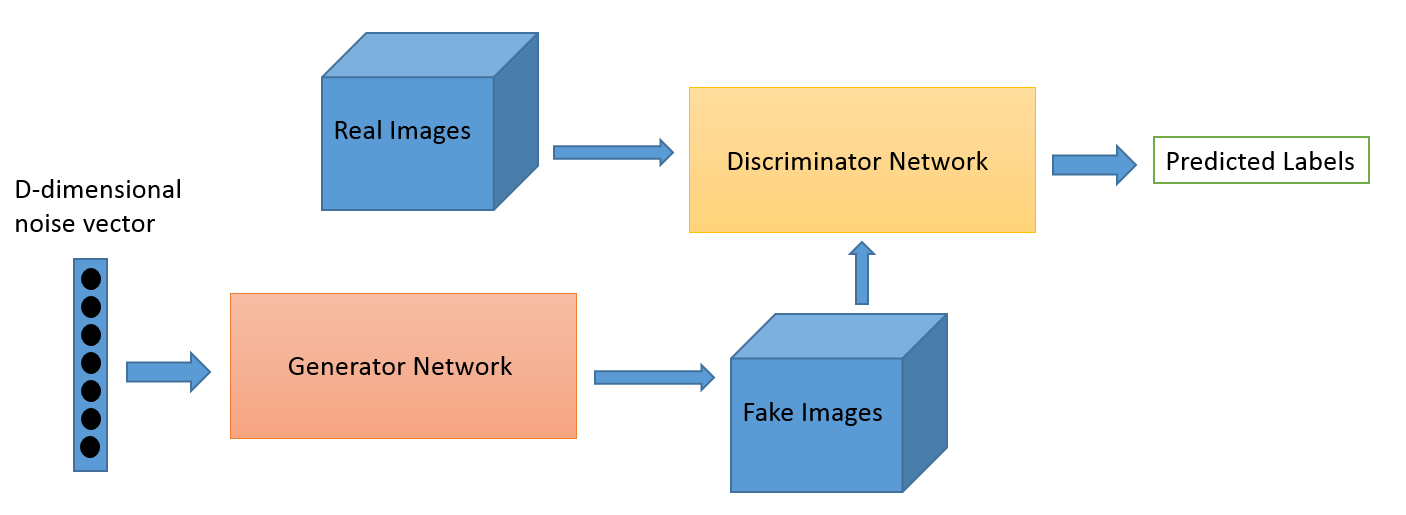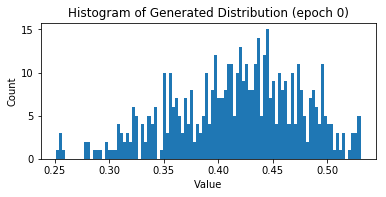David Mertz¶
- Data Scientist
- Chief Technology Officer, Bold Metrics Inc.
- Trainer
- Pythonista
[email protected]¶
When applied to images, GAN's often produce "surreal" and sometimes disturbing resemblances to real images.¶
While a GAN is technically a kind of unsupervised learning, it cleverly captures much of the power of supervised learning models.¶
(... what's the difference?)
Supervised learning¶
- Start out with tagged training data
- Classifiers predict target in several classes
- Regressors predict target in continuous numeric range
- Require initial mechanism to identify canonical answers (e.g. human judgement)
Unsupervised learning¶
- Data features, but no target per se
- No a priori to compare to prediction
- E.g. clustering, decomposition
Generative Adversarial Network¶
- Only examples of the positive class
- Implicit negative class of "anything else"
- The "adversaries" are supervised models
- The adversaries provide each other's targets!
Artist and AI enthusiast Robbie Barrat made these images derived from painted nudes:

Martin Giles in MIT Technology Review shows authentic seeming generated images of "fake celebrities:"

One neural network in a GAN is a "generator"
- Generate new data that cannot be distinguished from genuine samples
- We start with training datasets, but do not know what identifies correctness.
- Correctness is defined by "belonging to the training set"
- ...as opposed to being any other (distribution of) possible values for the features
The second neural network is a "discriminator."
- Distinguish synthetic samples from genuine ones
- The discriminator uses supervised learning, since we know which images are fake
Real world versus GANs:
- Real world data is rarely activately trying to fool a network
- GAN: generator is specifically trying to outwit the discriminator
However...
- In forgery or fraud, a malicious actor is trying to create currency, or artwork, or some other item that can pass inspection by (human or machine) discriminators
- In evolution, some organisms use camouflage to appear as something else
This O'Reilly Press illustration is a good overview of the structure of a GAN:

Super-Resolution¶
A fascinating application of GANs is super-resolution.
Essentially, we train the discriminator to recognize "high-resolution" and provide the generator with low-resolution, but real, images as its input vector.

Image credit: Christopher Thomas
A toy example¶
The code shown is adapted from a GAN written by Dev Nag in his blog post Generative Adversarial Networks (GANs) in 50 lines of code (PyTorch).
For simplicity of presentation, all this GAN is trying to learn is a Gaussian random distribution.
%matplotlib inline
from matplotlib import pyplot as plt
import numpy as np
from scipy.stats import skew, kurtosis
import torch
import torch.nn as nn
import torch.optim as optim
from torch import sigmoid, tanh, relu
# For demonstration, we can use CPU target if CUDA not available
device = torch.device('cpu')
# Check the status of the GPU (if present)
if torch.cuda.is_available():
torch.cuda.memory_allocated()
# *MUCH* faster to run on GPU
device = torch.device('cuda')
print(device)
cpu
Create the dataset¶
We can easily create samples from a Gaussian distribution. The features we will us to characterize a sample are the first four moments of the sample; we could easily use the raw points, or other abstractions of the "shape" of the data, as we wish.
def get_moments(d):
# Return the first 4 moments of the data provided
mean = torch.mean(d)
diffs = d - mean
var = torch.mean(torch.pow(diffs, 2.0))
std = torch.pow(var, 0.5)
zscores = diffs / std
skews = torch.mean(torch.pow(zscores, 3.0))
# excess kurtosis, should be 0 for Gaussian
kurtoses = torch.mean(torch.pow(zscores, 4.0)) - 3.0
final = torch.cat((mean.reshape(1,), std.reshape(1,),
skews.reshape(1,), kurtoses.reshape(1,)))
return final
# Data points
def d_sampler(n=500, mu=4, sigma=1.25):
"Provide `n` random Gaussian distributed points with mean `mu` and std `sigma`"
return torch.Tensor(np.random.normal(mu, sigma, n)).to(device)
def gi_sampler(m=500, n=1):
"Uniform-dist data into generator, NOT Gaussian"
return torch.rand(m, n).to(device)
preprocess = get_moments
Utility functions¶
def extract(v):
return v.data.storage().tolist()
def stats(v):
d = extract(v)
return (np.mean(d), np.std(d), skew(d), kurtosis(d))
Visualize a sample from the target distribution¶
Reminder of what we are trying to imitate with the GAN.
- Since these are samples, somewhat different each time we pull from distribution
- For a large sample (5000 here) the "shape" is obvious
v = d_sampler(5000)
print("Mean: %.2f | Std: %.2f | Skew: %.2f | Kurt: %2f" % stats(v))
plt.hist(v.cpu(), bins=100)
plt.title("A sample from the target distribution");
Mean: 4.02 | Std: 1.26 | Skew: 0.06 | Kurt: 0.050123
Visualize a sample from the target distribution (continued)¶
- In GAN presented here, samples are 500 points from the same distribution
- Looks much more "stochastic"
v = d_sampler()
print("Mean: %.2f | Std: %.2f | Skew: %.2f | Kurt: %2f" % stats(v))
plt.hist(v.cpu(), bins=100)
plt.title("A small sample from the target distribution");
Mean: 4.01 | Std: 1.27 | Skew: 0.04 | Kurt: -0.216963
Visualize the noise input¶
- Large sample:
v = gi_sampler(5000).flatten()
print("Mean: %.2f | Std: %.2f | Skew: %.2f | Kurt: %2f" % stats(v))
plt.hist(v.cpu(), bins=100)
plt.title("A sample from the noise distribution");
Mean: 0.50 | Std: 0.29 | Skew: 0.02 | Kurt: -1.169280
Visualize the noise input (continued)¶
- Small sample, per GAN used:
v = gi_sampler().flatten()
print("Mean: %.2f | Std: %.2f | Skew: %.2f | Kurt: %2f" % stats(v))
plt.hist(v.cpu(), bins=100)
plt.title("A small sample from the noise distribution");
Mean: 0.49 | Std: 0.28 | Skew: 0.13 | Kurt: -1.116548
Define the Models¶
Define a generator and a discriminator in a standard fashion for PyTorch models. Both have 3 linear layers.
class Generator(nn.Module):
def __init__(self, input_size, hidden_size, output_size, f):
super().__init__()
self.dropout = nn.Dropout(0.25)
self.map1 = nn.Linear(input_size, hidden_size)
self.map2 = nn.Linear(hidden_size, hidden_size)
self.map3 = nn.Linear(hidden_size, output_size)
self.f = f
def forward(self, x):
x = self.map1(x)
x = self.dropout(x) # Can we avoid a local trap?
x = self.f(x)
x = self.map2(x)
x = self.dropout(x) # Can we avoid a local trap?
x = self.f(x)
x = self.map3(x)
return x
class Discriminator(nn.Module):
def __init__(self, input_size, hidden_size, output_size, f):
super().__init__()
self.dropout = nn.Dropout(0.25)
self.map1 = nn.Linear(input_size, hidden_size)
self.map2 = nn.Linear(hidden_size, hidden_size)
self.map3 = nn.Linear(hidden_size, output_size)
self.f = f
def forward(self, x):
x = self.map1(x)
x = self.f(x)
x = self.map2(x)
x = self.f(x)
x = self.map3(x)
x = self.f(x)
return x
Instantiate models, loss, and optimizer¶
# Model parameters
minibatch_size = 4
num_epochs = 5001
print_interval = 500
d_steps = 20
g_steps = 20
G = Generator(input_size=1, # Random noise dimension, per output vector
hidden_size=10, # Generator complexity
output_size=1, # Single output for successful forgery or not
f=relu # Activation function
).to(device)
# Use input_size = get_num_features(...) if you try other examples
D = Discriminator(input_size=4, # 4 moments/features
hidden_size=10, # Discriminator complexity
output_size=1, # Single output for 'real' vs. 'fake' classification
f=sigmoid # Activation function
).to(device)
# Binary cross entropy: http://pytorch.org/docs/nn.html#bceloss
criterion = nn.BCELoss()
# Stochastic Gradient Descent optimizers
d_learning_rate = 2e-4
g_learning_rate = 2e-4
sgd_momentum = 0.9
d_optimizer = optim.SGD(D.parameters(), lr=d_learning_rate, momentum=sgd_momentum)
g_optimizer = optim.SGD(G.parameters(), lr=g_learning_rate, momentum=sgd_momentum)
Train the model¶
During training we will show some information and visualization of the progress.
def train(minibatch_size=500, g_input_size=1, d_input_size=500):
for epoch in range(num_epochs):
for d_index in range(d_steps):
# 1. Train D on real+fake
D.zero_grad()
# 1A: Train D on real
d_real_data = d_sampler(d_input_size)
d_real_decision = D(preprocess(d_real_data))
d_real_error = criterion(d_real_decision, torch.ones([1])) # ones = true
d_real_error.backward() # compute/store gradients, but don't change params
# 1B: Train D on fake
d_gen_input = gi_sampler(minibatch_size, g_input_size)
d_fake_data = G(d_gen_input).detach() # avoid training G on these labels
d_fake_decision = D(preprocess(d_fake_data.t()))
d_fake_error = criterion(d_fake_decision, torch.zeros([1])) # zeros = fake
d_fake_error.backward()
d_optimizer.step() # Only optimizes D's parameters;
# changes based on stored gradients from backward()
Train the model (continued #1)¶
#
for g_index in range(g_steps):
# 2. Train G on D's response (but DO NOT train D on these labels)
G.zero_grad()
gen_input = gi_sampler(minibatch_size, g_input_size)
g_fake_data = G(gen_input)
dg_fake_decision = D(preprocess(g_fake_data.t()))
# Train G to pretend it's genuine
g_error = criterion(dg_fake_decision, torch.ones([1]).to(device))
g_error.backward()
g_optimizer.step() # Only optimizes G's parameters
Train the model (continued #2)¶
#
if epoch % print_interval == 0:
rstats, fstats = stats(d_real_data), stats(d_fake_data)
print("Epoch", epoch, "\n",
"Real Dist: Mean: %.2f, Std: %.2f, Skew: %.2f, Kurt: %2f\n" % rstats,
"Fake Dist: Mean: %.2f, Std: %.2f, Skew: %.2f, Kurt: %2f" % fstats)
values = extract(g_fake_data)
plt.hist(values, bins=100)
plt.xlabel('Value')
plt.ylabel('Count')
plt.title('Histogram of Generated Distribution (epoch %d)' % epoch)
plt.grid(True)
plt.show()
Training results¶
In [14]: train()
Epoch 0
Real Dist: Mean: 4.01, Std: 1.29, Skew: 0.12, Kurt: -0.077075
Fake Dist: Mean: 0.42, Std: 0.06, Skew: -0.33, Kurt: -0.364491
Epoch 0
Real Dist: Mean: 4.01, Std: 1.29, Skew: 0.12, Kurt: -0.077075
Fake Dist: Mean: 0.42, Std: 0.06, Skew: -0.33, Kurt: -0.364491
Epoch 1000
Real Dist: Mean: 3.92, Std: 1.29, Skew: -0.03, Kurt: -0.284384
Fake Dist: Mean: 5.99, Std: 1.49, Skew: -0.08, Kurt: -0.246924
Epoch 2000
Real Dist: Mean: 4.02, Std: 1.32, Skew: -0.01, Kurt: -0.218719
Fake Dist: Mean: 4.61, Std: 2.78, Skew: 0.75, Kurt: -0.201242
Epoch 3000
Real Dist: Mean: 3.94, Std: 1.29, Skew: -0.18, Kurt: 0.539401
Fake Dist: Mean: 3.46, Std: 0.93, Skew: 0.28, Kurt: -0.450815
Epoch 4000
Real Dist: Mean: 3.93, Std: 1.23, Skew: 0.00, Kurt: 0.066148
Fake Dist: Mean: 4.24, Std: 0.89, Skew: -0.05, Kurt: 0.380818
Epoch 5000
Real Dist: Mean: 4.04, Std: 1.24, Skew: 0.06, Kurt: -0.326888
Fake Dist: Mean: 3.67, Std: 1.23, Skew: -0.22, Kurt: -0.475792Epoch 5000
Real Dist: Mean: 4.04, Std: 1.24, Skew: 0.06, Kurt: -0.326888
Fake Dist: Mean: 3.67, Std: 1.23, Skew: -0.22, Kurt: -0.475792
Pitfalls and guidelines¶
- When you train the discriminator, the generator will remain contant, and vice versa
- In a known domain, you might wish to pretrain the discriminator, or utilize a pre-trained model
- This gives the generator a more difficult adversary to work against
Pitfalls and guidelines (continued #1)¶
- One adversary of the GAN can overpower the other
- It depends on the network you configure
- It depends on learning rates, optimizers, loss functions, etc.
- If the discriminator is too good, it will return values close to 0 or 1
- The generator will be unable to find a meaningful gradient
- If the generator is too good, it will exploit weaknesses in the discriminator
- Simpler patterns than "authenticity" might fool a discriminator
- The surreal images demonstrate this
Pitfalls and guidelines (continued #2)¶
- In the blog post that I base this GAN on is an illustration of multiple trained generators
- Randomized initial conditions make a big difference!
- Sometimes additional training rounds may force networks out of a poor local maximum
- Often an unbalance is reached where progress is not possible
